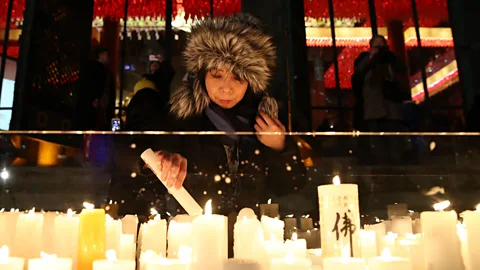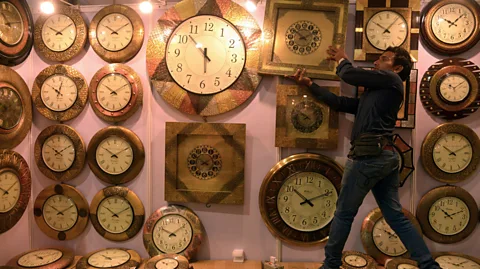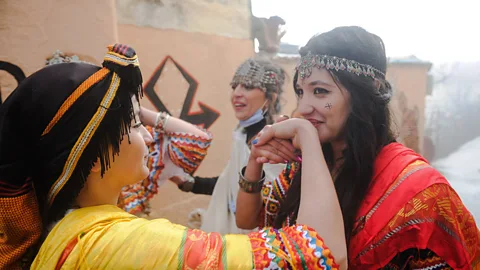The people who live in multiple timelines
 Getty Images
Getty ImagesMany people around the world live by different calendars, and for some this leads to some unusual birthday celebrations, says Erin Craig.
It wasn't until the third time I turned 40 that I began to get suspicious.
The first time I'd been a bit preoccupied and unprepared for the existential baggage of a milestone birthday – particularly since I thought I was only 38. I turned 40 again a few months later. Well, I never had been good at maths. But then I turned 41 a few times, and then 40 once more. Nope, time was clearly out of joint.
It turns out many cultures are fine with experiencing multiple years – or multiple ages – simultaneously. Right now it is the start of 2023 everywhere in the world. But step into Myanmar and it's also 1384, while Thailand will shoot you forward to 2566. Moroccans are praying in 1444 but farming in 2972, and Ethiopians are working their way through 2015, which for them has 13 months. Meanwhile in South Korea, where I live, New Year is everybody's birthday. This explains how I turned 40 three times.
Your South Korean age
I was 38 years old when I learned that I was actually 40 in South Korea. Korean age hinges on two dates: your birthdate and the Gregorian New Year. From your birthday to 31 December, you are one year older in Korea than you are in the UK or US. From 1 January to your next birthday, add two years.
South Koreans are born age one and from that point onward have two to three official ages at any given time: domestic, international (counting from zero), plus a bonus year when the entire country ages together on 1 January. (Symbolically, this can also happen at Lunar New Year.) Moreover, Koreans can choose whether to celebrate their personal birthdays in the Gregorian or the traditional lunar calendar. Technically, I could have exploited the system for six birthdays, but who's that glad to see 40?
This casual plurality was new to me, the misplaced American. I'd thought time was one of the few things we as a species agreed upon. Sure, people measured time differently in the past (Stonehenge was a giant calendar), but I wasn't used to thinking of other calendars as current. Certainly not concurrent. Mostly, I didn't question my own experience of time at all.
The slow road to now
Dates are background to our lives, and one of those things that just seem to exist. But of course any date (1 January 2023, for example) is the construct of a specific system of timekeeping, in this case the Gregorian calendar.
As the ISO-approved global-standard calendar, mandated across international sectors from aviation to politics, one might assume the Gregorian to be superlatively accurate and efficient. In fact, no. Its rise to dominance was largely a matter of right place, right time, right imperialist culture.
 Getty Images
Getty ImagesA product of religious doctrine and Renaissance science, the Gregorian calendar was created to correct drift between the Catholic liturgical year (then based on the Julian calendar) and the actual solar year. The Julian was only off by 11 minutes and 14 seconds – impressive maths for 45BC, but this discrepancy would inexorably add up over the centuries. By the time Pope Gregory XIII ordered a reform in the late 16th Century, the calendar year was roughly 10 days out of synch with the seasons.
Gregory's calendar got the lag down to 26 seconds. Yet its introduction in 1582 met with immediate resistance: neither Protestants nor Orthodox Christians were about to reimagine the concept of time based on a papal decree.
So only the Catholic parts of Europe adopted the new calendar in time to ring in 1600. Other regions slowly joined as the centuries ticked by: Protestant Germany and the Netherlands for 1700, England and its colonies by 1800. As of 1900, such far-flung, non-Christian places as Japan and Egypt had incorporated it into their timekeeping methods, yet Orthodox countries like Romania, Russia, and Greece held out well into the 20th Century. It wasn't until 2000 that Europe unanimously greeted a new century on Gregorian 1 January.
You may also like:
However, most major imperial powers were on Gregorian time by the mid-19th Century, when a period of colonisation brought more than 80% of the globe under European rule. This coincided with a movement among Euro/American scientific and business communities for a universal World Calendar to facilitate commerce. Almost by default the Gregorian got the role.
In regions Europe didn't conquer, the calendar spread through other means. In her book The Global Transformation of Time, historian Vanessa Ogle suggests capitalism, evangelism, and a scientific passion for uniformity did more to standardise time than any imperialist policy. Colonialism wasn't even an essential factor. Beirut was under Ottoman rule when Gregorian dates appeared in its almanacs during the late 1800s. Japan was never colonised at all, yet adopted the Gregorian calendar in 1872. This acceptance may have been eased by the knowledge that the relationship wouldn't be monogamous.
 Getty Images
Getty ImagesMultiple calendar use existed for millennia before the Gregorian came along. The ancient Egyptians and Mayans both used two calendars, one religious and the other administrative. King Sejong of Korea specifically commissioned two systems for his 1430s calendar reform – one adapted from the Chinese calendar, one from the Arabic. In 1880s Beirut, the Gregorian was just one of four calendars in everyday use. Even Japan, which ostensibly switched entirely to Gregorian time, retained its system of imperial dating, the Rokuyo calendar of auspicious days, and the 24 Sekki calendar of seasonal changes – all of which are still used today.
Social anthropologist Clare Oxby, who has studied calendar use in the Sahel and the Sahara, coined the term "calendar pluralism" to describe the coexistence of multiple timekeeping systems, much as legal pluralism describes societies with multiple systems of law. This might sound like a juggling act, but in practice different calendars have different functions. In north Africa, Imazighen, Tuareg, and other Berber-speaking communities may use three or four systems simultaneously: stellar calendars mark agricultural seasons; the Islamic lunar calendar guides religious practice; the Gregorian dictates interactions with the government. Living in multiple timelines can be a practical way to unite differing temporal needs.
This isn't an unfamiliar concept in Europe and North America: people have school years and fiscal years, for example. In many ways, it's just a matter of where you start counting.
"Probably the parallel use of multiple calendars is much more present in our contemporary world than we thought," says Oxby. But while pluralism has been a historical constant, calendars themselves change all the time. Those in use today may look different even a few decades down the road. "You may have more and you may have different ones. Human culture is constantly evolving."
 Getty Images
Getty ImagesOne ongoing cultural shift is our expansion into the digital realm. Fibre-optic cables have taken the place of old trade routes, carrying the Gregorian calendar places colonialism couldn't reach. And for the moment at least, connectivity has created a new kind of calendar pluralism.
Nepal is one of the few countries on Earth where the Gregorian isn't a national calendar – officially the year is either 2079 (Bikram Sambat) or 1143 (Newari Nepal Sambat) or both. Altogether, at least four calendars are used among different ethnic groups, with a variety of new years. Nepal is even 15 minutes out of sync with standard time zones. This is a country with its own temporal thing going on.
Despite this, there's no reason for individual Nepalis like Sanjeev Dahal to use multiple calendars at all.
"I've only used the Bikram Sambat calendar," says Dahal, "I've never used the Nepal Sambat ever in my life." It's not exactly monotemporalism – the Bikram Sambat contains several layers of cultural and religious timekeeping within its solar year, 12 lunar months, and six seasons – but for a Hindu living in Kathmandu this one system covers all aspects of daily life from fast days to payday.
However, while he only needs one calendar inside Nepal, Dahal is a remote PhD student at Boston College, studying the Nepali diaspora. This means he is intractably involved in another culture's calendar: digital culture, which, like 19th-Century imperialist Europe, is almost exclusively Gregorian.
"I exist in two spaces and times," says Dahal, who tackles this technological conundrum with a technological solution. His laptop is set for 2023 and his smartphone for 2079. An app helps him navigate between the two on the fly.
Dahal sees a generational divide in calendar use: his parents have no use for Gregorian time at all. But among his friends there's also a functional divide, where Gregorian is for business and Bikram Sambat for social and family events. And while the Western calendar dominates social media (and thus when people wish him happy birthday), it's useless for important aspects of Nepali culture like determining auspicious days and tracking lunar cycles. For this reason, Dahal doesn't see the Gregorian getting official sanction any time soon.
 Getty Images
Getty ImagesHistory may well run in circles. As with the World Calendar movement of the late 19th Century, the 21st Century has seen a push toward calendar unity for economic reasons. In 2016, Saudi Arabia shifted government workers' pay schedule from the Islamic to Gregorian calendar in what was largely interpreted as a cost-cutting measure. In December, South Korea passed a bill dispensing with traditional ages on the grounds that the multi-age system is economically inefficient. The law will go into effect sometime this year, which means my next birthday may only arrive twice or even singly.
But what might be lost or gained in consolidating around a single calendar – particularly one created to fit another time and place?
"Well, governments can gain control by imposing centralised calendars," says Oxby, who has written on the power dynamics of calendar use. "The nation can lose out on cultural history and diversity. The people can lose out. If they're part of a minority regional culture, they may feel undervalued at a national level."
Then again, 150 years of globalisation haven't made pluralism obsolete. Calendars may come and go; more often they change. And if there's one thing humans are good at, it's change.
Now, if you'll excuse me, it's the beginning of 2023 – so I have a birthday party to attend.
--
If you liked this story, sign up for the weekly bbc.com features newsletter, called "The Essential List" – a handpicked selection of stories from BBC Future, Culture, Worklife, Travel and Reel delivered to your inbox every Friday.
